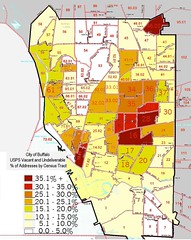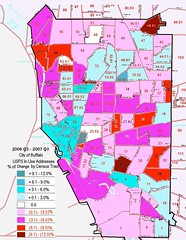Go ahead. Pick out your census tract and see what's really happening here in Buffalo. Both maps here represent some pretty serious demographic trends. First map represents what's happening at the end of September 2007. The second map compares 2006 and 2007 third quarter trends. Serious evidence about the 'hollowing out' of our neighborhoods.
Anthony writes...
The USPS has been sharing this data since the first quarter (the period of January 1 – March 31) of 2006 (Q1 2006), providing for a year-to-year comparison of current vacancy trends. However, longer term historical change cannot be derived from this data set.
A cursory analysis of this data reveals by the end of the first quarter of 2007 (Q1 2007) Buffalo had lost 1,692 deliverable addresses since Q1 2006, representing a decrease of 1.4% of the city’s total addresses. During that time, the total number of all addresses fell 527, from 137,292 to 136,765 for a decrease of .4%. After accounting for demolition activity, then, this translates to 1,162 more undeliverable addresses than last year at this time.
The data continues to reflect the uneven market conditions across the city. While some areas experienced a large number of new vacancies, other areas remained stable or experienced an increase in addresses in service. However, as the above statistics show, the aggregate gains are outweighed by the aggregate losses. For example, the district roughly bounded to the west by Fillmore Avenue, Bailey Avenue to the east, to the north by East Delevan and the south by Clinton Street, has shown a significant decline, with some tracts showing a year-over-year decrease in deliverable addresses in excess of 10% and overall vacancy rates of nearly 40%.
I've placed the corresponding data set in downloadable format right here that reveals trends in Buffalo by planning area from January 2006 - September 2007.
Readers here may remember some of LISC's heavy lifting last year that I wrote Getting Smarter about Decline, last November. I posted about Anthony's analysis of Postal Service data - No One is Home - in May 2007 when I first looked at this on going study. Shrinking Buffalo has some valuable links if you're still in denial.
Byron?
Artspace • BAVPA • Woodlawn Row Houses • faq • my flickr
the creativity exchange • top ten or eleven



3 comments:
I assume that you are attempting to bring light to the poverty issue but this, again, is the result of our declined economy and lack of job opportunities to individuals who are more skilled at manual labor than any technical position.
Also, generally speaking, the African American community seem to live a more transient lifestyle; perhaps due to their frequent inability to sustain employment or the fact that their priorities are in ownership of clothes and automobiles where a home, or house, is nothing more than a dumping ground strewn with litter after their departure to another hovel where the process begins all over again.
Having grown-up working class ethnic Irish our home was clean; our clothes, albeit a tad threadbare, were clean and when my grandfather passed –on in 1985 he still had his 1969 Oldsmobile ~ culture differences is the cause of racism but when a sub-culture destroys an entire region I think it is time to stop citing poverty as the main issue.
I assume, generally speaking, it seems, perhaps, the fact of your assumption that African Americans (a sub-culture!!??)only care about clothes and automobiles discounts the larger impact of the huge population exodus that has contributed to the decline of these neighborhoods.
The city should be looking entire census tracts to remove in a planned effort. There should be incentives to get homeowners in these to sell and move closer to the core in existing houses there. Or they would move eventually like is happening anyways, leaving the houses behind. There should other tracts dedicated to new-build and preservation closer to the core. Pool our gov't services and money into a concentrated area.
Labeling the AA race as transients and the cause is over simplifying things. What about all those that moved out before they moved in? How many people do we see that stop putting money in their houses because they are getting scared of the return on it and they instead move farther out to a newer area a soon as they can? Why do we expect those with less money to show the way in preservation and upkeep when those with money don't do it to begin with? As a societal whole, the US treats is housing/neighborhoods/cities etc as disposible. Too much money, land, cheap transportation etc make it easier to pick up and go that to vest oneself into a location and fight for it when the time comes.
Post a Comment